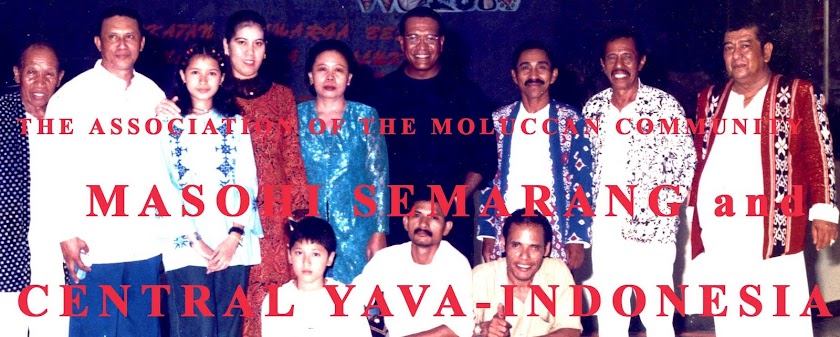Makan Patita
The Moluccas, or Maluku, a group of islands scattered in the glittering waters of eastern Indonesia and one of the most desired destinations for those looking for fame and riches back in the 15th century, is home to centuries-old customs that are still practiced to this day.
One of those customs is makan patita from central Maluku. Not only in small villages but also in larger towns, this joyful event is still very popular and brings together families and friends.
The makan patita, or patita, is held for special events. For example, when an old family house needs a cleansing then a cuci baleo has to be organized. Following the cleansing, makan patita will be served to those who were so kind to assist the hosts.
Another custom, found mostly in villages, is the sasi, which is when villagers give foodstuffs to the head of the village to donate to the church or needy people in the village. Foods like coconuts, sago and other staples like cassava, sweet potatoes and taro are collected and donated.
To properly serve a makan patita after a cuci baleo, numerous coconut leaves are neatly arranged on an open space, which could be in the garden of a house or the plaza in front of a church. Banana leaves are used to form a second layer. This will be done after a special ceremony is conducted by the village elder or the reigning raja, because according to the people there old houses are the dwelling places of the souls of ancestors who still guide the village.
Placed on the mats are boiled sweet potatoes, cassava, bananas and other foods and dishes brought by those participating. Special dishes are sagu presko (grilled sago); papeda, a sago porridge; ketupat santan, which is cooked in coconut milk; ikan asar (grilled fish); colo-colo, a spicy condiment; koh-kohu (see recipe); and acar kuning, sweet and sour turmeric flavored with raw or boiled cucumber and cabbage.
Hunters from the village will also bring foods like wild pig and deer. To lessen the thirst traditional drinks will be offered. Sageru manis, for instance, a fermented sago drink.
The village elder will sit among the villagers watching the young men and women, juraro and mungare, dancing the lenso and singing traditional songs accompanied by traditional musical instruments like the tifa. A makan patita could last until the wee hours of the morning.
So, eat, drink and be merry when attending makan patita.
Speaking about the food of Maluku, it has migrated around the archipelago over the years and so many dishes or snacks are renowned fare here. Take for instance nasi kuning Ternate, which is today a popular dish at many events. The story goes that a king of Ternate visited Surakarta and brought his own cook to prepare specific foods for the royal hosts. They liked the food so much that until today the dishes are still on the menus of many Surakarta households.
The guests from Maluku also brought with them their sweet delicacies. Bika Ambon, a luscious honeycomb cake, is one of the best examples, but uniquely do not go to Ambon when looking for a super bika Ambon, but go to Medan where in the preparation process a specific raising agent is used!
Last but not least: are you on a banana diet? If so eat pisang Ambon! The bananas from Ambon are the first fruits given to babies at the very tender age of three months.
By the way, many cookies and snacks use cassava meal. Though cassava meal is sold at markets or supermarkets, many farmers make the cassava meal themselves.
Here is how to make cassava meal at home: Grate or thinly slice one kilogram of fresh and clean peeled cassava roots. Dry under the sun for 48 hours, and it is better to begin the drying process in the morning to obtain the best results. Then grind manually or with an electric grinder. Sift and grind the coarse parts once again or until completely ground. One kilogram of freshly grated cassava yields approximately 400 grams of cassava meal. Store in open plastic bags.
Back to makan patita. Wishing you a good time with Maluku food, drinks and melodious songs!
RECIPES
Koh-kohu
A traditional dish from Ambon made from raw vegetables and tuna.
Ingredients: 400 g fresh tuna, cleaned 1 tsp salt or to taste 1 Tbs lime juice Charcoal, for grilling 4 strings long beans 100 g mung bean sprouts 100 g small, round eggplants 3 shallots 10 chili paddy, stems discarded A handful of picked kemangi leaves 100 g grated fairly young coconut, steamed 2 Tbs lime juice 1 tsp salt or to taste
Preparation:
1. Make 4 slices on the dorsal side of the tuna, coat with salt and lime juice. 2. Grill over charcoal until done. 3. Remove bones and shred the fish meat. 4. Wash long beans and cut very thinly. Remove blackish part of the sprouts and wash in hot water, drain. Wash eggplants using same procedure and slice thinly. 5. Wash shallots and chili paddy and slice thinly. Also wash kemangi leaves, drain. 6. Mix the shredded tuna meat with the raw vegetables and add the steamed shredded coconut, lime juice and salt. Let stand for 10 minutes in a cool place or in the refrigerator before serving.
(Makes 6-7 servings. Mostly served with boiled cassava or sago)
Pindang Rempah Cumi
Squid spiced with a special spice combination.
Ingredients: 500 g fresh squid 2 Tbs lime juice 4 shallots 3 cloves garlic 3 red chilies 1 tsp ground coriander 1 tsp ground cumin, 1 tsp ground pepper 1 tsp fried trassi 1 slice turmeric 2 Tbs cooking oil, for stir frying 1 slice ginger, bruised 1 slice of galangal, bruised 3 purut lime leaves 1 screwpine leaf 100 ml water 1 tsp salt, or to taste 2 Tbs tamarind liquid 50 g kenari nuts, peeled
Preparation: 1. Pull off tentacles and any foreign matter from the squid. Discard all the entrails of the body and peel off the membrane from the hood. Clean and coat with lime juice. Let stand for 15 minutes to marinate. 2. Make shallots, garlic, red chilies, ground coriander, ground cumin, ground pepper, trassi and turmeric into a paste. Stir fry until aromatic. Add ginger, galangal, purut lime leaves, screwpine leaf and squid. Continue frying until squid changes color. 3. Pour in water and let come to a boil. Season with salt, tamarind liquid and kenari nuts. Continue cooking until done.
(Makes 4 servings)
Ubi Kayu Halmahera
A sweet snack from the islands of Maluku.
Ingredients: 250 g ground sugar 40 g margarine or butter 3 hen eggs 500 g grated cassava, liquid squeezed out 125 g grated fairly young coconut 1 tsp baking powder 200 ml milk A pinch of salt 100 g raisins 100 g peeled kenari nut, chopped 1 Tbs margarine or butter, for greasing 1 Tbs wheat flour, for dusting
Preparation: 1. Beat sugar and margarine or butter until whitish. Add hen eggs one by one while beating. 2. Add grated cassava, grated coconut, mix. Add baking powder, milk, salt and raisins and 50 g chopped kenari nuts. Mix well. 3. Take a suitable pan, grease with margarine or butter and dust with flour. Pour in the grated cassava mixture and bake until done and rather brownish.
(Makes 6-7 servings)
























0 komentar:
Post a Comment